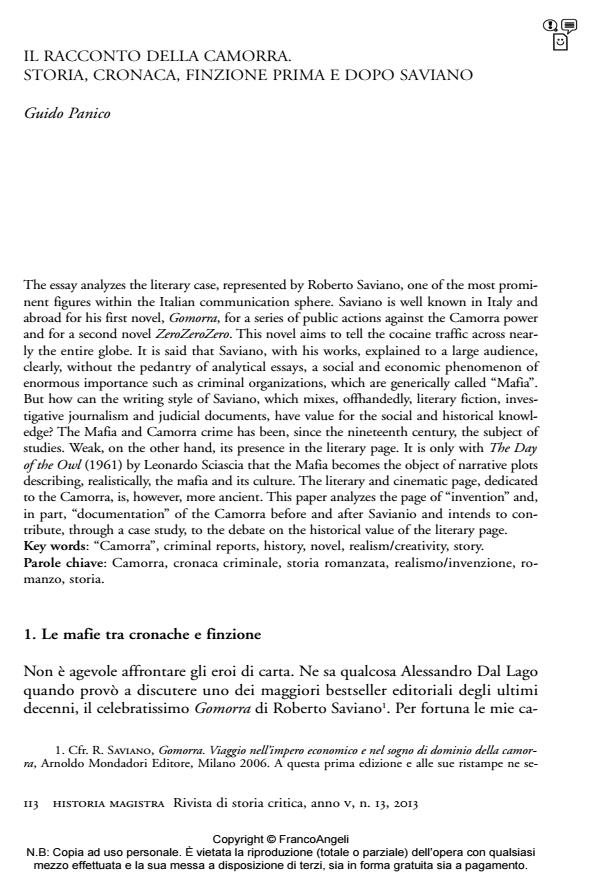Il racconto della camorra. Storia, cronaca, finzione prima e dopo Saviano
Titolo Rivista HISTORIA MAGISTRA
Autori/Curatori Guido Panico
Anno di pubblicazione 2014 Fascicolo 2013/13
Lingua Italiano Numero pagine 12 P. 113-124 Dimensione file 545 KB
DOI 10.3280/HM2013-013012
Il DOI è il codice a barre della proprietà intellettuale: per saperne di più
clicca qui
Qui sotto puoi vedere in anteprima la prima pagina di questo articolo.
Se questo articolo ti interessa, lo puoi acquistare (e scaricare in formato pdf) seguendo le facili indicazioni per acquistare il download credit. Acquista Download Credits per scaricare questo Articolo in formato PDF

FrancoAngeli è membro della Publishers International Linking Association, Inc (PILA)associazione indipendente e non profit per facilitare (attraverso i servizi tecnologici implementati da CrossRef.org) l’accesso degli studiosi ai contenuti digitali nelle pubblicazioni professionali e scientifiche
The essay analyzes the literary case, represented by Roberto Saviano, one of the most prominent figures within the Italian communication sphere. Saviano is well known in Italy and abroad for his first novel, Gomorra, for a series of public actions against the Camorra power and for a second novel ZeroZeroZero. This novel aims to tell the cocaine traffic across nearly the entire globe. It is said that Saviano, with his works, explained to a large audience, clearly, without the pedantry of analytical essays, a social and economic phenomenon of enormous importance such as criminal organizations, which are generically called "Mafia". But how can the writing style of Saviano, which mixes, offhandedly, literary fiction, investigative journalism and judicial documents, have value for the social and historical knowledge? The Mafia and Camorra crime has been, since the nineteenth century, the subject of studies. Weak, on the other hand, its presence in the literary page. It is only with The Day of the Owl (1961) by Leonardo Sciascia that the Mafia becomes the object of narrative plots describing, realistically, the mafia and its culture. The literary and cinematic page, dedicated to the Camorra, is, however, more ancient. This paper analyzes the page of "invention" and, in part, "documentation" of the Camorra before and after Savianio and intends to contribute, through a case study, to the debate on the historical value of the literary page
Parole chiave:Camorra, cronaca criminale, storia romanzata, realismo/invenzione, romanzo, storia
Guido Panico, Il racconto della camorra. Storia, cronaca, finzione prima e dopo Saviano in "HISTORIA MAGISTRA" 13/2013, pp 113-124, DOI: 10.3280/HM2013-013012